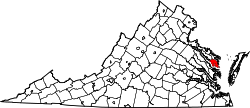Ottoman, Virginia | |
|---|---|
 Hartswell Baptist Church on River Road | |
| Coordinates: 37°42′07″N76°31′12″W / 37.70194°N 76.52000°W | |
| Country | United States |
| State | Virginia |
| County | Lancaster |
| Time zone | UTC−5 (Eastern (EST)) |
| • Summer (DST) | UTC−4 (EDT) |
Ottoman is an unincorporated community in Lancaster County located on the Northern Neck of the Rappahannock River in the U.S. state of Virginia. [1]
Contents
Locustville, a historic plantation house built in 1855, was listed on the National Register of Historic Places in 1994. [2]


